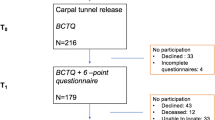Summary
In a retrospective study 157 patients with electrophysiologically proven carpal tunnel syndrome (CTS) were followed up. Of the 85 operatively treated patients, 86% showed clear improvement or cure, as did 32% of the patients not operated upon. Multivariate analysis of variance (MANOVA) and linear discriminant analyses indicated atrophy and length of history as effective predictors of clear improvement. The optimized discriminant point was ascertained in the receiver operator characteristics (ROC) curve. A predictive value of positive test of 0.89 was found for the course form “not cured” and a predictive value of negative test of 0.75 for the course form “cured” with a prevalence of one-third for the good course form. The prognosis was bad if atrophy occurred or the history exceeded 7 months. The determination of distal motor latency is indispensable for diagnosing CTS. For prognosis, however, length of history and clinical findings have been more helpful.
Zusammenfassung
In einer retrospektiven Studie konnten 157 Patienten mit einem elektrophysiologisch gesicherten CTS nachuntersucht werden. Bei 86% der 85 operativ behandleten Patienten war eine deutliche Besserung oder Heilung eingetreten. Aber auch bei 32% der nicht operierten Patienten war eine deutliche Besserung bzw. Heilung zu verzeichnen. Die multivariate Varianz- und lineare Diskriminanzanalyse bei 68 nicht operierten Patienten zeigten Atrophie und Anamnesedauer als geeignete Prädiktoren für eine deutliche Besserung. Der optimierte Diskriminanzpunkt wurde in der ROC-Kurve ermittelt. Dabei ergab sich ein predictive value of positive test von 0,89 für die Verlaufsform nicht geheilt und ein predictive value of negative test von 0,75 für die Verlaufsform geheilt bei einer Praevalenz von einem Drittel für die gute Verlaufsform. Die Prognose ist schlecht bei auftretenden Atrophien oder einer Anamnesedauer von über 7 Monaten. Die Bestimmung der distalen motorischen Latenz ist für die Diagnose eines CTS unerläßlich. Für prognostische Aussagen sind jedoch die Dauer der Anamnese und die klinischen Befunde bedeutungsvoller.
Similar content being viewed by others
References
Aebi-Ochsner Ch, Ludin HP (1979) Das Karpaltunnelsyndrom — klinische Symptomatologie und elektrophysiologische Befunde. Neurol Psychiatr 47:307–319
Ahrens H, Läuter J (1981) Mehrdimensionale Varianzanalyse. Akademie-Verlag, Berlin
Behringer U (1972) Das Karpaltunnelsyndrome. Schweiz Med Wochenschr 102:52–58
Benini A (1975) Das Karpaltunnelsyndrom und die übrigen Kompressionssyndrome des N. medianus. Thieme, Stuttgart
Both R, Mühlau G, Wieczorek V (1979) Das Karpaltunnelsyndrome. Dtsch Gesundheitswes 34:22–27
Cseuz KA, Thomas JE, Lambert EH, Love JG, Lipscomb PR (1966) Long term results of operation for carpal tunnel syndrome. Proc Mayo Clin 41:232–241
Fardin P, Negrin P, Carteri A (1979) Clinical and electromyographical considerations on 150 cases of carpal tunnel syndrome. Acta Neurol Scan 73:121
Harris CM, Tanner E, Goldstein MN, Pettee DS (1979) The surgical treatment of the carpal-tunnel-syndrome correlated with nerve-conduction studies. J Bone Joint Surg [Am] 61:93–98
Lachenbruch PA (1967) An almost unbiased method of obtaining confidence intervals for the probability of misclassification in discriminant analysis. Biometrics 23:639–645
Ludin HP (1976) Praktische Elektromyographie. Enke, Stuttgart
Manz F (1974) Konservative Behandlung des leichten Karpaltunnelsyndroms. Nervenarzt 45:387–388
Mühlau G (1983) Klinische und elektrophysiologische Befunde bei umschriebenen Läsionen peripherer Nerven. Wiss Z EMA Univ. Greifswald (in press)
Mühlau G, Both R, Reichel G (1976) Zur Bestimmung der distalen Latenz der motorischen Handnerven. Psychiat Neurol Med Psychol (Leipzig) 28:226–228
Mumenthaler M (1962) Über Lähmungen peripherer Nerven im Extremitätenbereich. Dtsch Med Wochenschr 87:1887–1896, 1967–1972
Mumenthaler M (1974) Charakteristische Krankheitsbilder nicht unmittelbar traumatischer peripherer Nervenschäden. Nervenarzt 45:61–66
Sunderland S (1976) The nerve lesion in the carpal tunnel syndrome. J Neurol Neurosurg Psychiatry 39:615–626
Tschibane S, Ohmade T, Yads K (1979) Prognosis in carpal tunnel syndrome: a comparison between the natural history and operative treatment. Acta Neurol Scand 73:120
Author information
Authors and Affiliations
Rights and permissions
About this article
Cite this article
Mühlau, G., Both, R. & Kunath, H. Carpal tunnel syndrome—course and prognosis. J Neurol 231, 83–86 (1984). https://doi.org/10.1007/BF00313722
Received:
Issue Date:
DOI: https://doi.org/10.1007/BF00313722




